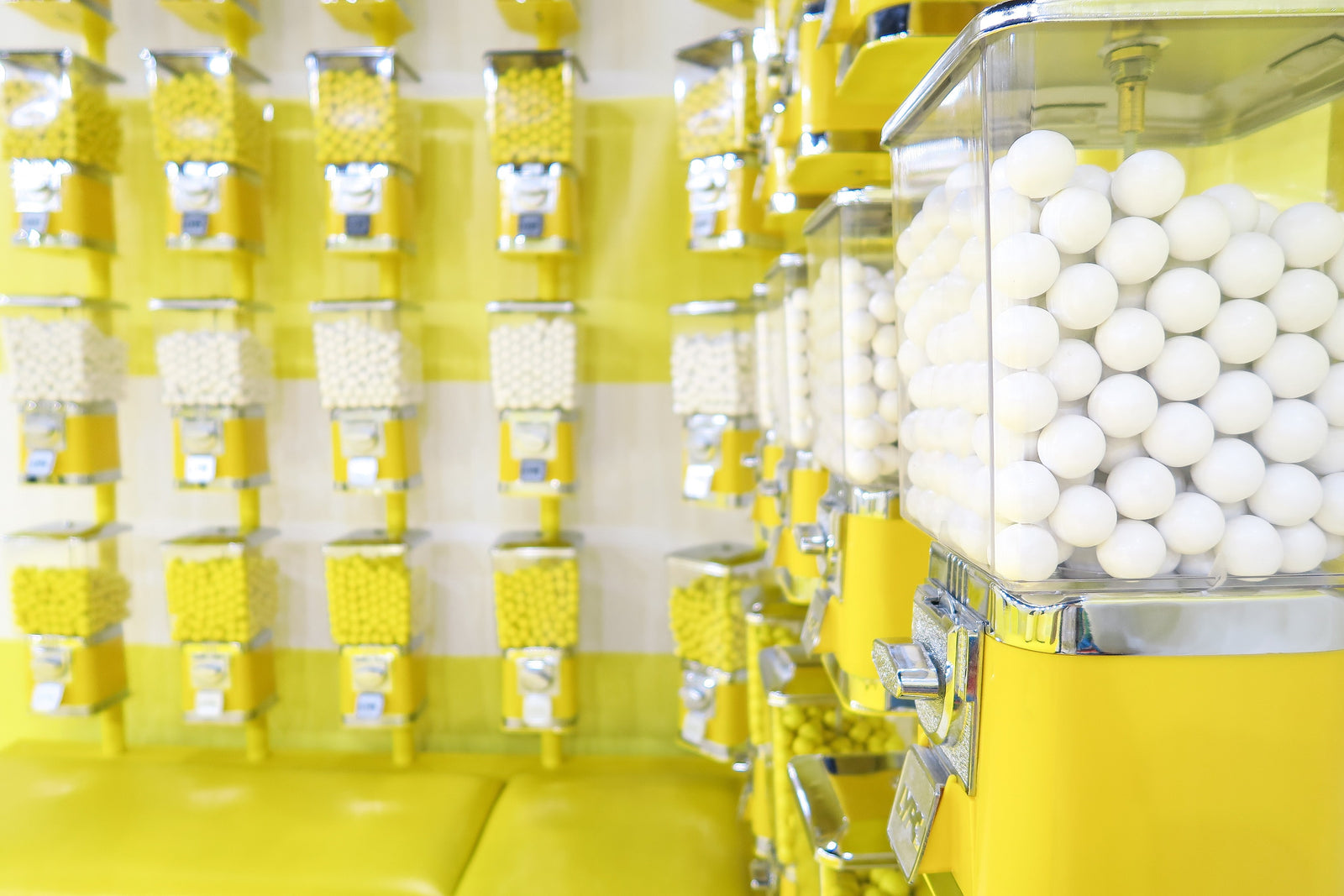🚚 FREE USA SHIPPING ON ORDERS OVER $30! INTERNATIONAL SHIPPING AVAILABLE.
🚚 FREE USA SHIPPING ON ORDERS OVER $30! INTERNATIONAL SHIPPING AVAILABLE.
What is chewing gum made of?
by Mark Miller 4 min read

Chewing gum manufacturing equipment
You may have been chewing gum all of your life, but you don't know what's in it. Chewing gum has four main ingredients: gum base, flavors, colors, and sweeteners.
The International Chewing Gum Association, based in Washington, D.C., says [1]:
A simple piece of chewing gum is actually an assembly of four primary components that, depending on ingredients selected, can produce virtually infinite varieties to please every palette. Each of these components has been the subject of extensive study and research to ensure that it not only performs its intended function but, most important, is safe.
Centuries and millennia ago, the process of making gum wasn't so well-researched. People chewed tree resin in Europe, and chicle in Central America and Mexico.
You might have heard of Chiclets, a gum popular in the United States until 2016, when it was discontinued. The Mexican product was reintroduced into the U.S. market in 2019.

Obviously, the name Chiclets is derived from chicle, which was the base of commercial gum until around World War II, when American gum manufacturers started using an artificial base. Chicle is the latex sap of the sapodilla tree.
In modern times, gum makers carefully keep private the exact ingredients they use, but the ingredients types are well-known.
The ingredients of chewing gum
1. Gum base
Around the mid-1900s, chemists learned to make synthetic rubber. This became the base ingredient for most brands of chewing gum, says the site Chewing Gum Facts [2]. That said, some companies use both natural and artificial ingredients in the base.
The ICGA says:
Chewing gum base is the non-nutritive, insoluble component of chewing gum that provides its basic “chewable” matrix, and it is formulated to gradually release flavors, sweeteners, and functional ingredients during sustained chewing. These “masticatory substances” may be made from natural or synthetic gums, to which are added various softeners, texturizers, and other functional ingredients. Gum base ingredients used by ICGA members have been tested for safety and are approved for use in chewing gum in conformance with applicable national laws where the chewing gum is manufactured or sold.
2. Flavors
The most common and standard flavors are fruit, mint, and cinnamon. The ICGA calls flavor a defining characteristic of chewing gum types.
Though those are the most common flavors, there are many others around the world. Can you imagine the following conversation in Japan:
"Hello. Would you like a piece of chewing gum?"
"Yes, thank you. May I ask what flavor it is?"
"Man Smell."
"Excuse me?"
It's not what you think. It is not the smell of a man, but rather is meant to impart a pleasing smell to the men who chew it.
Other weird flavors include meatball, wasabi, mint chocolate chip, and TV dinner. Still others are Thanksgiving meal, foie gras, pickle, black pepper and fruit, and motitas banana. [3]
3. Colors
Color is pretty straightforward. Cinnamon gum is red. Fruit gum is colored like the flavor of the fruit. For example, lime gum is green, lemon or citrus is yellow, and watermelon is red. And many mint gums are green, too, or white.
A video showing some gum and mint manufacturing processes
Reputable gum companies do not use harmful food coloring. The ICGA says:
ICGA members use only food colors expressly approved under applicable national or international standards and regulations, which are grounded on rigorous testing to ensure safety.
4. Sweeteners
The Chewing Gum Facts site says:
Sweeteners are added to gum to give it that sweet flavor. Those ingredients are usually sugar, corn syrup and even beet juice. Sugar is probably the healthiest off all sweeteners. There are many synthetic sweeteners, but the most used are xylitol, sorbitol, mannitol and aspartame ...
The International Chewing Gum Association says the sweeteners also enhance the flavor of the gum.
The association identifies three types of sweeteners: nutritive sweeteners like traditional sugars; bulk sweeteners like sugar alcohol with no calories and do not cause tooth decay; and intense sweeteners like aspartame that are free of calories and also do not cause tooth decay.
Gum manufacturers also add softeners to keep the gum moist and prevent it from becoming too hard after prolonged chewing. Softeners consist of glycerin and vegetable oils.
Sugar-free gum with caffeine
Viter Energy has just come out with mint and cinnamon sugar-free gum with caffeine. Because it is sugar-free, you don't have those added calories. And the caffeine has been shown to help the body burn more fat and calories.
People who chew caffeinated gum are cautioned to watch their other caffeine intake. In other words, don't chew 4 sticks of gum and have 4 cups of coffee, or you may exceed the daily recommended limit of 400 mg of caffeine.
Viter Energy Gum [4] is powerfully flavored sugar-free chewing gum that contains caffeine, guarana and B Vitamins. For several years, Viter Energy has been producing caffeinated mints [5] but recently expanded to sell caffeinated gum.
A Viter Energy blog [6] explains about guarana that it is a vine that first grew wild in South America. Guaraná (Paullinia cupana), also known as Brazilian cocoa, grows as a shrub or woody vine in Brazil. Because Guaraná seeds have the highest caffeine content (2.5%-5%), it’s been used in Brazilian soft drinks since 1909.
Viter Energy Gum [7] comes in mint and cinnamon flavors. It delivers caffeine over a sustained period of time, but the caffeine kicks in quicker than even a cup of coffee or an energy drink.
Sources:
[1] http://www.gumassociation.org/index.cfm/science-technology/ingredients-technology/
[2] http://www.chewinggumfacts.com/making-chewing-gum/chewing-gum-ingredients/
[3] https://www.thedailymeal.com/travel/worlds-13-weirdest-gum-flavors-slideshow
[6] https://www.goviter.com/blogs/viter-energy-blog/plants-around-world-contain-caffeine
Also in Viter Energy Blog

Can caffeine help with ED?
by Mark Miller 3 min read
Erectile dysfunction. In combination, those are two of the ugliest words known to man. But can caffeine help you get it up?
Science hasn't found the definitive answer to this question, but one study concluded that fewer men who consume caffeine have problems performing. The study said:
Caffeine intake reduced the odds of prevalent ED, especially an intake equivalent to approximately 2-3 daily cups of coffee (170-375 mg/day). This reduction was also observed among overweight/obese and hypertensive, but not among diabetic men. Yet, these associations are warranted to be investigated in prospective studies

Caffeine while breastfeeding? Go ahead, it's OK
by Mark Miller 4 min read
Many breastfeeding mothers wonder if it's OK to take caffeine. In fact, many nursing mothers just avoid caffeine in case it would keep their babies fussy, jittery and awake.
The answer is yes, you can take caffeine while breastfeeding, as long as you don't go over about 300 mg a day.
It's an important question because caffeine is in so many products, and taking coffee, tea, or soda is such a common ritual.
And breastfeeding mothers may be tempted to take caffeinated products because they are deprived of sleep by their newborns' odd sleep schedule.

The surprising benefits of chewing gum
by Mark Miller 5 min read
You might think gum chewing is an activity with little or no benefits besides the pleasure and flavor, but think again. Chewing gum has several benefits.
In addition to freshening your breath, sugar-free gum can help prevent cavities and contribute to overall oral health. But that's just the beginning.

